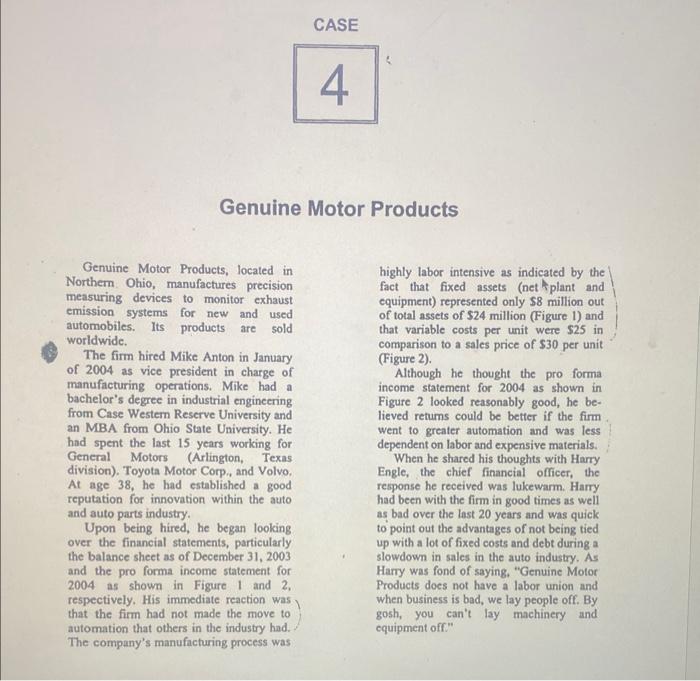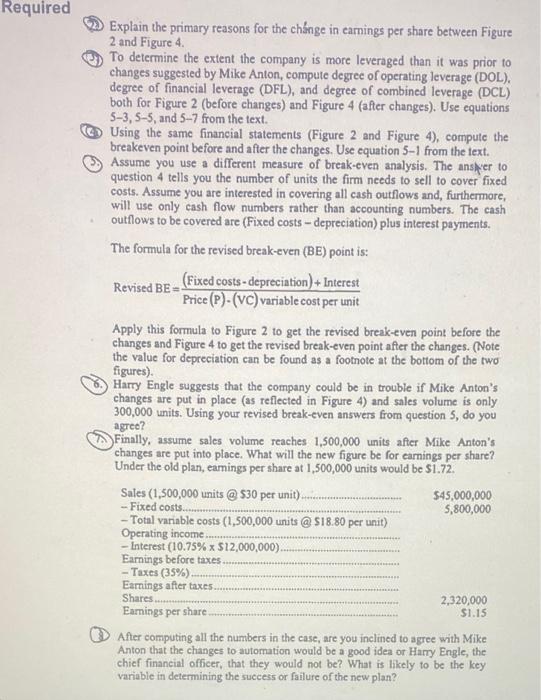Please solve 1-8 under the required section(they are circled on the last 2 pages) and dont do Q5. For question 7 earnings per share=$ 2.72 not $1.15

Genuine Motor Products Genuine Motor Products, located in Northern. Ohio, manufactures precision highly labor intensive as indicated by the measuring deviees to ment that fixed assets (net is plant and emission systems for new and used equipment) represented only $8 million out automobiles. Its products are sold of total assets of $24 million (Figure 1) and worldwide. that variable costs per unit were $25 in The firm hired Mike Anton in January comparison to a sales price of $30 per unit (Figure 2). bachelor's degree in industrial engineering Figure 2 looked reasonably good, he befrom Case Western Reserve University and lieved retums could be better if the firm an MBA from Ohio State University. He went to greater automation and was less had spent the last 15 years working for dependent on labor and expensive materials. General Motors (Arlington, Texas When he shared his thoughts with Harry division). Toyota Motor Corp, and Volvo. Engle, the chief financial officer, the At age 38, he had established a good response he received was lukewarm. Harry reputation for innovation within the auto had been with the firm in good times as well and auto parts industry. Upon being hired, he began looking as bad over the last 20 years and was quick over the financial statements, particularly to point out the advantages of not being tied the balance sheet as of December 31, 2003 up with a lot of fixed costs and debt during a and the pro forma income statement for slowdown in sales in the auto industry. As 2004 as shown in Figure 1 and 2 , Harry was fond of saying, "Genuine Motor respectively. His immediate reaction was ) when business is bad, we lay people off. By that the firm had not made the move to gosh, you can't lay machinery and automation that others in the industry had. equipment off." The company's manufacturing process was GENUINE MOTOR PRODUCTS Balance Sheet As of December 31,2003 Current assets Assers Fixed assets Plant and equipment. Less: accumulated depreciation. Net plant and equipment. Total assets. $20,000,00012,000,0008,000,000$24,000,000 Current liabilities. Liabilities and Stockholders' Equity Long-term liabilities: Bonds payable 10.75%. Total liabilities. Stockholders' equity: Common stock, 51 par value, 2,000,000 shares. Capital in excess of par. Retained earnings.. Total stockholders' equity. Total liabilities and stockholders' equity. GENUINE MOTOR PRODUCTS Pro forma Income Statement For 2004 Sales (1,000,000 units @ $30 per unit)...... - Fixed costs . . $16,000,000 530,000,000 2,000,000 25,000,000 Operating income (EBIT) units @ $25 per unit $3,000,00025,000,000 - Interest (10.75%52,000,000). Earnings before taxes. - Taxes ( 35% ). Earnings after taxes. Shares. Earnings per share. $12,000,0002,000,000 52,000,0004,000,0006,000,000$12,000,000$24,000,000 - Fixed costs includeS 1,000,000 in depreciation In spite of Harry's arguments, Mike Anton was determined to show the impact of both operating and financial leverage on Genuine Motor Products operations. He reconstructed the year-end balance sheet for 2003 (previously shown in Figure 1), and the results are shown in Figure 3 based on the following assutnptions. 1. That the firm would increase fixed assets by $14 million dollars. 2. That $10 million of the $14 would be funded through long-term debt in the form of additional bonds payable at an interest rate of 10.75%. 3. The remaining $4 million would come from the sale of additional common stock at a net price to the corporation of $12.50. This would require the issuance of 320,000 new shares ( $4 millior/ $12.50=320,000 shares). The impact of these values on the balance sheet in Figure 3 shows substantially greater leverage both on the asset and liability side. The intent of using more leverage was to increase the potential profitability of the firm. You are called in as a financial analyst to rework the 2004 pro forma income statement based on the assumptions stated in Table 1. These primarily relate to the fact there are now more fixed assets, long-term debt, and shares outstanding. Table 1 Assumptions for Revised Pro Forma Income Statement 1. Sales will remain constant at 1,000,000 units at $30 per unit. 2. Fixed costs will increase from $2,000,0000 to $5,800,000, a gain of $3,800,000. (Depreciation expense will be $2,800,000 and this will be shown as a footnote in the 2004 pro forma income statement). 3. Variable cost per unit will be reduced from $25 to $18.80. A total of 1,000,000 units will still be sold. The reduction in variable costs per unit is a direct result of the increased fixed costs and the associated automation. 4. Interest expense will reflect that there is now $12 million in long-term debt in the form of bonds payable at 10.75%. Ten million dollars of new debt is being added to 52 million of old debt. 5. Shares outstanding are now at a level of 2,320,000. Three hundred and twenty thousand new shares are being added to the 2,000 old shares currently outstanding. Required Complete the revised pro forma income statement below. In the process, refer back to Figure 2, the original pro forma income statement for 2002 and the assumptions in Table 1. The new statement you are developing below will be referred to as Figure 4 for purposes of reference. (22) Explain the primary reasons for the chnge in earnings per share between Figure 2 and Figure 4. To determine the extent the company is more leveraged than it was prior to changes suggested by Mike Anton, compute degree of operating leverage (DOL), degree of financial leverage (DFL), and degree of combined leverage (DCL) both for Figure 2 (before changes) and Figure 4 (after changes). Use equations 53,55, and 57 from the text. (CD) Using the same financial statements (Figure 2 and Figure 4), compute the breakeven point before and after the changes. Use equation 51 from the text. Assume you use a different measure of break-even analysis. The ans/yer to question 4 tells you the number of units the firm needs to sell to cover fixed costs. Assume you are interested in covering all cash outflows and, furthermore, will use only cash flow numbers rather than accounting numbers. The cash outflows to be covered are (Fixed costs - depreciation) plus interest payments. The formula for the revised break-even (BE) point is: RevisedBE=Price(P)(VC)variablecostperunit(Fixedcostsdepreciation)+Interest Apply this formula to Figure 2 to get the revised break-even point before the changes and Figure 4 to get the revised break-even point after the changes. (Note the value for depreciation can be found as a footnote at the bottom of the two figures). 8. Harry Engle suggests that the company could be in trouble if Mike Anton's changes are put in place (as reflected in Figure 4) and sales volume is only 300,000 units. Using your revised break-even answers from question 5 , do you agree? A. Finally, assume sales volume reaches 1,500,000 units after Mike Anton's changes are put into place. What will the new figure be for earnings per share? Under the old plan, eamings per share at 1,500,000 units would be $1.72. (B) After computing all the numbers in the case, are you inclined to agree with Mike Anton that the changes to automation would be a good idea or Harry Engle, the chief financial officer, that they would not be? What is likely to be the key variable in determining the suecess or failure of the new plan












